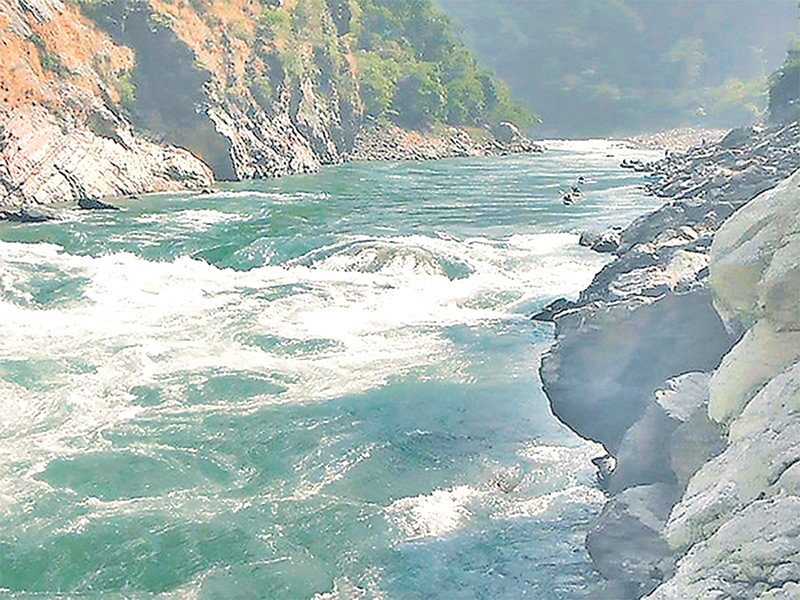Nepal’s high hope on the West Seti Hydropower Project is yet to be materialized despite the willingness of the Government to kick off the project as soon as possible. Recently, the Investment Board Nepal (IBN) has formed a seven-member panel to study and recommend measures to sort out the issues arising in the development of West Seti Project, a reservoir project of 750 MW.
The project involves making of hydro-electric dam on the Seti River in the Far-Western Development Region of Nepal. The power station would be located approximately 63 kilometers (39 mi) upstream of the Seti River confluence with the Karnali River, with the dam site located a further 19.2 kilometers (11.9 mi) upstream. All project sites, excluding the reservoir area and transmission line corridor, are located in either Doti and/or Dadeldhura Districts. The reservoir area is located in Doti, Dadeldhura, Baitadi and Bajhang Districts. The transmission line corridor is located in Doti, Dadeldhura, and Kailali and Kanchanpur districts. The reservoir-type West Seti project is being built at an estimated cost of $1.6 billion.
The dam would be a 195-metre (640 ft) high concrete-face rock-fill dam. The dam’s catchment area covers the upper 4,022 square kilometers (1,553 sq mi) of the Seti River Basin and its reservoir volume would be 1.5 km3 (1,200,000 acre⋅ft) of with 926,000,000 m3 (751,000 acre ft) would be active (or “useful”) storage. The reservoir’s surface would cover an area of 20.6 km2 (8.0 sq mi) and stretch 25.1 km (16 mi) up river. To produce power, the design calls for a 6.7 km (4 mi) long headrace tunnel which would divert water around 19.2 km (12 mi) of the river’s bend to the power station.[1] The power station would have a rated capacity of 750 MW. The drop in elevation from the reservoir to the power station would afford a hydraulic head of 259 m (850 ft).
The construction of the West Seti project has not been materialized since long. In August 2012, the China Three Gorges Corporation (CTGC) subsidiary CWE Investment Corporation and Investment Board of Nepal (IBN) signed a Memorandum of understanding (MoU) to construct the hydropower project. The dam was to be built by Snowy Mountain Engineering Corporation (SMEC) under West Seti Hydropower Company Limited (WSHPL) under the earlier arrangement. However, in June 2011 the Government terminated the construction license due after SMEC failed to construct it. In 2010, the WSHPL lost two important investors, the Asian Development Bank and China National Machinery and Equipment Import and Export Corporation. A campaign by organizations opposing the dam also impacted construction. The dam was opposed based on its impact of the environment and relocation of residents. In May 2011, the CTGC expressed its interest in developing the project. In December 2011, Nepal’s Ministry of Energy proposed a public–private partnership after CTGC’s interest.
In fact, it took more than five years to sign a joint venture agreement between CTGC and Nepal Electricity Authority (NEA), its venture partner in the project. As per the MoU, the Chinese company will have a 75 percent stake in the joint venture company while the NEA will hold the rest of the shares. The West Seti Hydropower Project is expected to generate 2.8 billion units of electricity per year. The estimated construction time of the project, which will have a 207-metre tall dam, is six and a half years.
The panel formed by the Investment Board Nepal (IBN) is required to look into the issue of tariff which has become a bone of contention between NEA and the joint venture partner China Three Gorges Corporation (CTGC). The Corporation claimed that the current tariff did not make the project feasible and demanded assurance for a rate of return on investment. During a meeting with IBN on 4th March 2018 the Chinese company reiterated that the 750 MW storage project would not be bankable at the power purchase rate fixed by the government and asked the board to guarantee a 17 percent return on the project. As per the power purchase rate made public by the Energy Ministry in January 2017, reservoir-type projects like the West Seti will get Rs 12.40 per unit during the dry season which lasts from December to May, and Rs 7.10 per unit during the wet season which lasts from June to November.
The Chinese developer has also asked IBN to allow hydropower projects to sell electricity in convertible currency for a period of more than 10 years. As per the existing guideline, hydropower projects can sell electricity in convertible currency for a period of up to 10 years or until the project has repaid foreign debts, whichever is earlier. The scheme will cost $1.8 billion including interest charges incurred during the construction period and $1.4 billion excluding interest charges, according to the NEA. As noted above, the two partners will invest in the project through their proposed joint venture company, West Seti Hydropower Project Development Limited. CTGC also had advised the board to customize the capacity of the power plant, but IBN officials and NEA were not able to decide the issue on their own.
Under the current arrangement, the CTGC has a 75 percent stake in the project, and the Nepal Electricity Authority has the rest 25 percent. The IBN’s 29th board meeting led by Prime Minister K P Oli on 9 March 2018 decided to form the panel led by a secretary of the Office of the Prime Minister. According to a press release issued on Friday, the panel will come up with a concrete future plan within a month. This is the first board meeting of IBN after Oli assumed office in February.
The seven members in the panel include officials from the Ministry of Irrigation and Energy, Investment Board Nepal, Ministry of Finance, Nepal Electricity Authority and local stakeholders. The panel may also take expert opinion.

